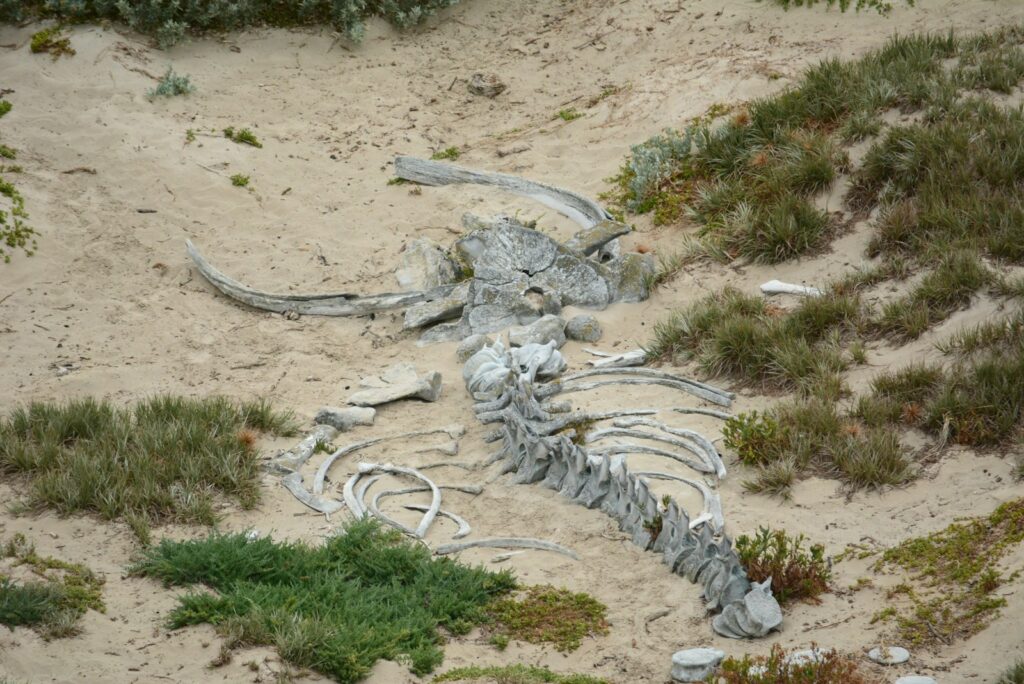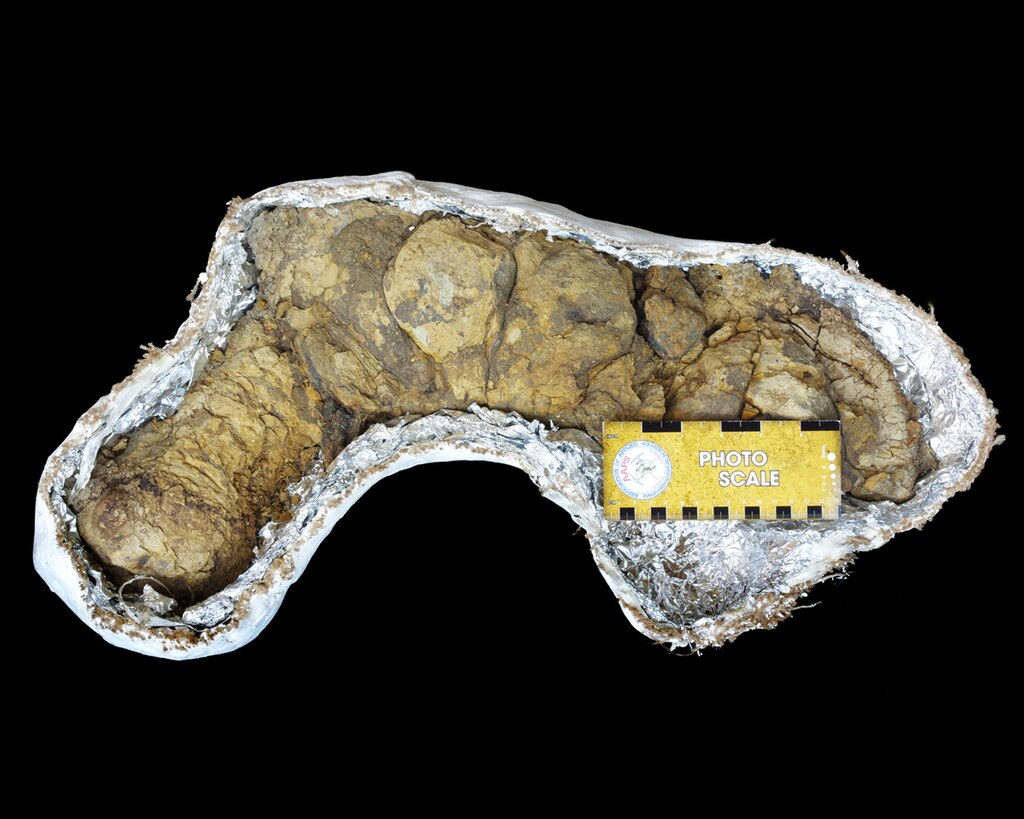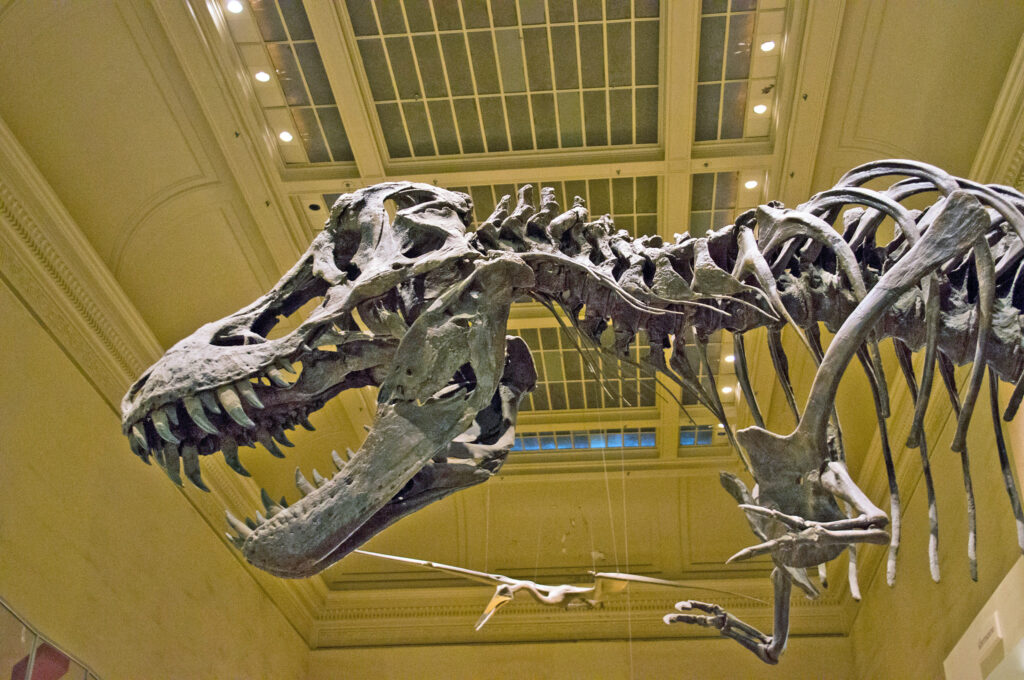Picture this: a massive Tyrannosaurus rex dies near an ancient riverbank 70 million years ago. Heavy rains and flooding carry its bones downstream, eventually washing them into prehistoric oceans where massive sharks patrol the depths. It sounds like something out of a science fiction movie, but this scenario might have been more common than we think. The idea of sharks encountering dinosaur remains in ancient seas opens up fascinating questions about prehistoric ecosystems and the unexpected connections between land and marine life millions of years ago.
When Dinosaurs Ruled the Land and Sharks Ruled the Seas
During the Mesozoic Era, spanning roughly 252 to 66 million years ago, our planet looked dramatically different from today. Dinosaurs dominated terrestrial environments while sharks had already been perfecting their predatory skills in the oceans for over 200 million years. These two groups of ancient creatures existed simultaneously for an incredible stretch of time, with sharks actually predating dinosaurs by about 150 million years. The Late Cretaceous period, in particular, saw both groups thriving in their respective domains. What’s remarkable is that many shark species from this era were giants compared to today’s sharks, with some reaching lengths of 80 feet or more. While dinosaurs evolved into countless forms on land, sharks remained the apex predators of prehistoric seas.
The Science Behind Bone Preservation in Ancient Oceans
When organic material like dinosaur bones enters marine environments, several fascinating processes begin immediately. Saltwater acts as a natural preservative in many cases, slowing down bacterial decomposition that would normally break down organic matter quickly on land. The chemistry of ancient oceans was different from today’s seas, often containing higher levels of minerals that could help fossilize bones more rapidly. Cold, deep ocean waters provided ideal conditions for preservation, creating environments where bones could remain intact for extended periods. However, the preservation process wasn’t guaranteed – many factors including water temperature, oxygen levels, and sediment burial rates all played crucial roles. Some bones would have been perfectly preserved while others dissolved completely, depending on these environmental conditions.
How Dinosaur Remains Could Have Reached the Ocean
Rivers and streams served as nature’s conveyor belts, transporting dinosaur carcasses and bones from inland areas to coastal regions and eventually out to sea. Massive flooding events, which were common during the Mesozoic Era, could carry entire skeletons hundreds of miles downstream. Coastal dinosaurs that died near shorelines would have been particularly likely to end up in marine environments through wave action and tidal forces. Hurricanes and powerful storms could have also played a role, dragging terrestrial remains far out into ocean waters. The process wasn’t always immediate – some bones might have spent years being gradually transported downstream before finally reaching the ocean. Once in the water, ocean currents could carry these remains vast distances from their original locations.
Ancient Shark Species That Lived Alongside Dinosaurs
The prehistoric oceans were home to some truly spectacular shark species that would make today’s great whites look modest in comparison. Cretoxyrhina, known as the “Ginsu Shark,” was a 25-foot monster with serrated teeth perfect for slicing through tough materials like bone. Squalicorax sharks, smaller but numerous, possessed teeth ideal for both cutting flesh and crushing harder materials. The massive Ptychodus had flat, crushing teeth that could easily break down bone, though they primarily fed on shellfish. These ancient sharks had already evolved sophisticated hunting strategies and powerful jaws capable of processing various types of organic matter. Their tooth shapes and jaw structures suggest they were opportunistic feeders, willing to investigate and consume whatever protein sources they encountered. The diversity of shark species during this time means different types would have had different capabilities for processing dinosaur bones.
Evidence from the Fossil Record
Paleontologists have discovered intriguing fossil evidence that suggests interactions between marine predators and terrestrial remains. Shark teeth have been found embedded in or near dinosaur fossils in several locations around the world, though determining the exact circumstances of these encounters remains challenging. Some dinosaur bones show distinctive bite marks that match the tooth patterns of large prehistoric sharks. Marine sediments from the Cretaceous period occasionally yield dinosaur bones alongside shark fossils, suggesting these materials were deposited in the same marine environments. However, interpreting this evidence requires careful analysis to distinguish between scavenging behavior and post-mortem transportation. The fossil record provides tantalizing clues but rarely offers complete pictures of these ancient interactions.
The Nutritional Value of Bones for Sharks
Bones aren’t just hard calcium structures – they contain significant amounts of protein, fats, and minerals that would have been valuable to ancient sharks. The bone marrow, in particular, is rich in nutrients and fats that could provide substantial energy for large predators. Collagen, the protein that gives bones their flexibility, would have been digestible by sharks with powerful stomach acids. Modern sharks are known to consume bones when other food sources are scarce, and their digestive systems can break down calcium phosphate over time. For prehistoric sharks living in nutrient-poor deep ocean environments, any source of protein would have been worth investigating. The calcium from bones could even have provided essential minerals for the sharks’ own skeletal development and maintenance.
Shark Digestive Capabilities and Bone Processing
Sharks possess remarkably powerful digestive systems designed to break down tough materials, including bones and shells. Their stomach acid is incredibly strong, with pH levels that can dissolve calcium-based materials over time. The spiral valve structure in shark intestines maximizes the surface area for nutrient absorption, allowing them to extract maximum value from every meal. Ancient sharks likely had similar or even more powerful digestive capabilities than their modern descendants. Their teeth were perfectly designed for different feeding strategies – some for cutting, others for crushing, and still others for gripping and tearing. This diversity in dental equipment suggests that prehistoric sharks were well-equipped to handle various types of organic matter, including tough dinosaur bones.
Ocean Currents and the Distribution of Dinosaur Remains
The ancient ocean circulation patterns would have played a crucial role in distributing dinosaur remains across prehistoric seas. Deep ocean currents could carry bones thousands of miles from their point of entry, potentially delivering them to shark populations far from the original dinosaur habitats. Upwelling currents might have brought these remains closer to the surface, making them more accessible to sharks that typically hunted in shallower waters. The Cretaceous period featured different continental configurations and ocean basins, creating unique current systems that don’t exist today. Some areas would have acted as natural collection points for floating debris, including dinosaur bones. These convergence zones might have created feeding opportunities for sharks that learned to patrol these areas regularly.
Seasonal Patterns and Mass Mortality Events
Certain times of the year would have been more likely to deliver dinosaur remains to the oceans, particularly during seasonal flooding or migration periods. Mass mortality events, such as those caused by volcanic activity, disease outbreaks, or climate changes, could have provided massive amounts of organic matter to marine ecosystems. These events might have created feeding bonanzas for sharks, with numerous carcasses entering the ocean simultaneously. Drought periods followed by heavy rains could have concentrated decomposing remains in river systems before washing them out to sea all at once. Sharks, being intelligent predators, might have learned to associate certain seasonal patterns with increased food availability. The timing of these events would have been crucial in determining whether sharks encountered fresh bones or heavily decomposed remains.
Adaptations for Scavenging Behavior
Many prehistoric sharks likely developed specialized scavenging behaviors to take advantage of unusual food sources like dinosaur bones. Their highly developed sense of smell could detect decomposing organic matter from miles away, drawing them to potential feeding sites. Some species might have evolved specific techniques for processing bones, such as using their powerful jaws to crack them open and access the nutritious marrow inside. Social feeding behaviors could have emerged, with multiple sharks working together to break down large bone structures. The ability to switch between active hunting and opportunistic scavenging would have been a significant survival advantage in the ancient oceans. These behavioral adaptations might have been passed down through generations, creating lineages of sharks particularly skilled at processing terrestrial remains.
Geographic Hotspots for Shark-Dinosaur Interactions
Certain geographic regions would have been more likely to witness interactions between sharks and dinosaur remains based on factors like river systems, coastal geography, and ocean circulation patterns. The Western Interior Seaway of North America, which split the continent during the Late Cretaceous, would have been an ideal location for such encounters. River deltas and estuarine environments provided natural funneling points where terrestrial remains could accumulate before dispersing into deeper waters. Shallow continental shelves allowed for easier access to floating or sunken dinosaur bones by various shark species. Coastal upwelling zones might have concentrated nutrients and organic matter, attracting both sharks and creating ideal conditions for bone preservation. These geographic factors would have created predictable hotspots where prehistoric marine predators could reliably find unusual food sources.
The Role of Decomposition and Timing
The state of decomposition when dinosaur remains reached sharks would have greatly influenced whether and how these interactions occurred. Fresh carcasses with intact flesh would have been more attractive to sharks than bare bones, but even heavily decomposed remains could provide nutritional value. The journey from death site to ocean could take weeks or months, during which bacterial action and environmental factors would alter the remains significantly. Bones that retained attached soft tissues would have been more appealing to sharks and easier to detect through chemical cues in the water. Cold ocean temperatures could slow decomposition, preserving remains longer and extending the window for shark encounters. The timing of when bones entered the ocean relative to local shark populations and their feeding cycles would have been crucial in determining whether interactions actually occurred.
Modern Parallels and Comparative Evidence
Today’s oceans provide valuable insights into how prehistoric shark-dinosaur interactions might have unfolded, as modern sharks regularly scavenge on whale carcasses and other large organic remains. Great white sharks and tiger sharks are known to consume bones when investigating carcasses, demonstrating that this behavior is well within shark capabilities. Marine forensic studies show that organic material can travel surprising distances in ocean currents while remaining attractive to scavengers. Modern river systems occasionally wash terrestrial animal remains out to sea, where they’re quickly discovered by marine predators. Scientists have documented cases of sharks consuming unusual items, including bones from land animals that somehow ended up in marine environments. These contemporary examples suggest that prehistoric sharks would have been equally opportunistic when encountering dinosaur remains in ancient seas.
Implications for Understanding Ancient Ecosystems
The possibility of sharks feeding on dinosaur bones reveals fascinating connections between terrestrial and marine ecosystems that existed millions of years ago. These interactions suggest that ancient food webs were more complex and interconnected than previously imagined, with energy and nutrients flowing between different environments in unexpected ways. Understanding these connections helps scientists reconstruct more complete pictures of prehistoric life and the relationships between different groups of ancient organisms. The evidence challenges traditional views of dinosaurs and sharks as completely separate groups that never interacted, instead suggesting a more dynamic relationship between land and sea during the Mesozoic Era. Such insights contribute to our broader understanding of how ecosystems function and how different species adapt to exploit available resources. The study of these ancient interactions continues to reveal new aspects of prehistoric life that surprise and delight researchers and the public alike.
While we may never know for certain how often sharks encountered dinosaur bones in ancient seas, the evidence suggests these interactions were not only possible but likely occurred with some regularity. The combination of powerful river systems, opportunistic shark behavior, and the long coexistence of these two groups creates a compelling case for prehistoric connections we’re only beginning to understand. What other unexpected relationships might have existed in the ancient world that we haven’t yet discovered?



